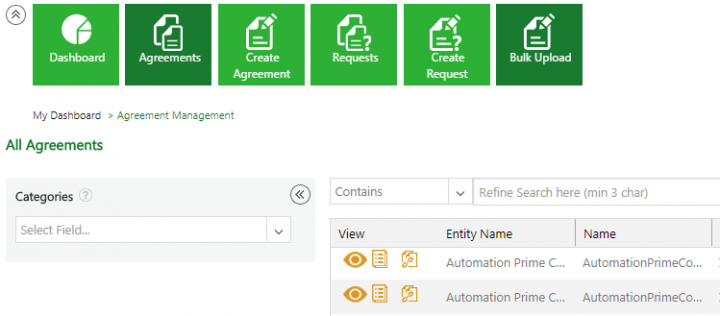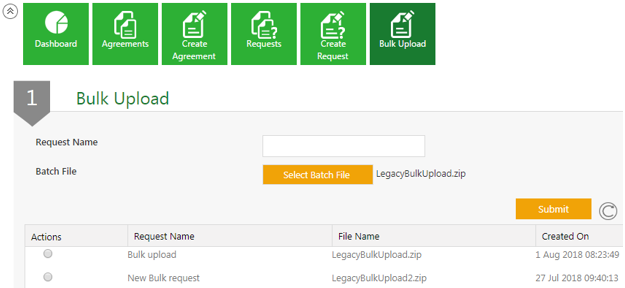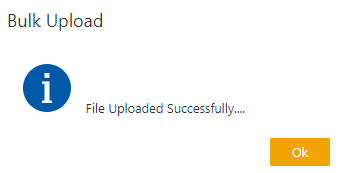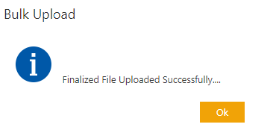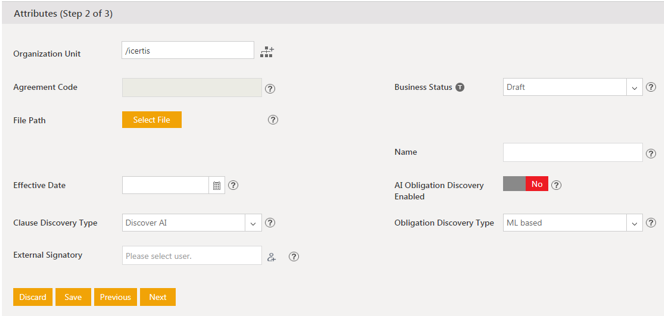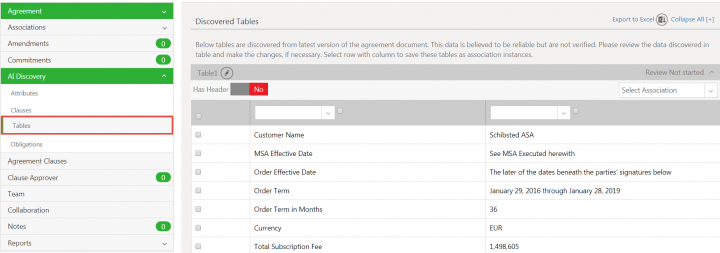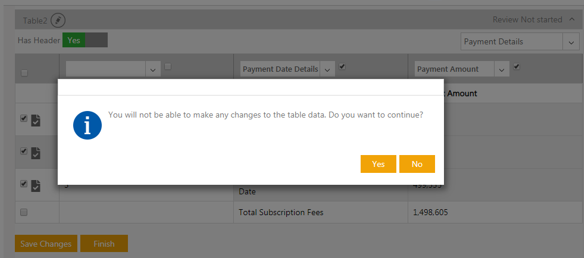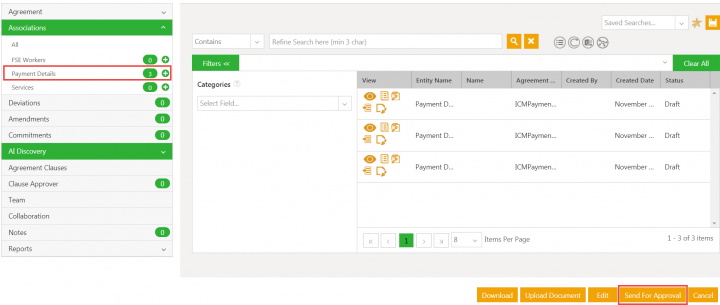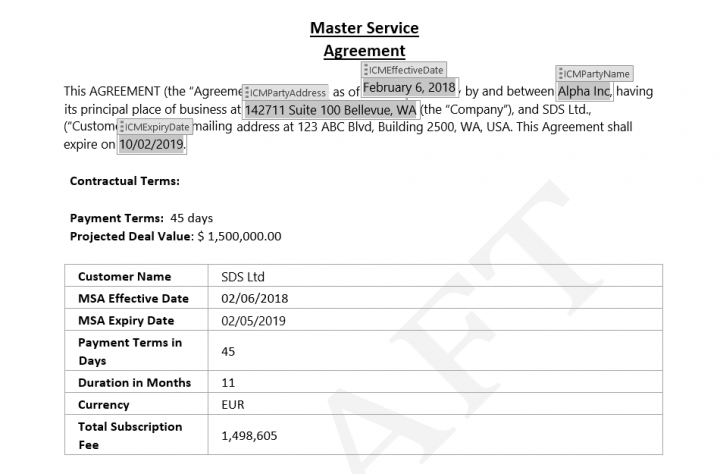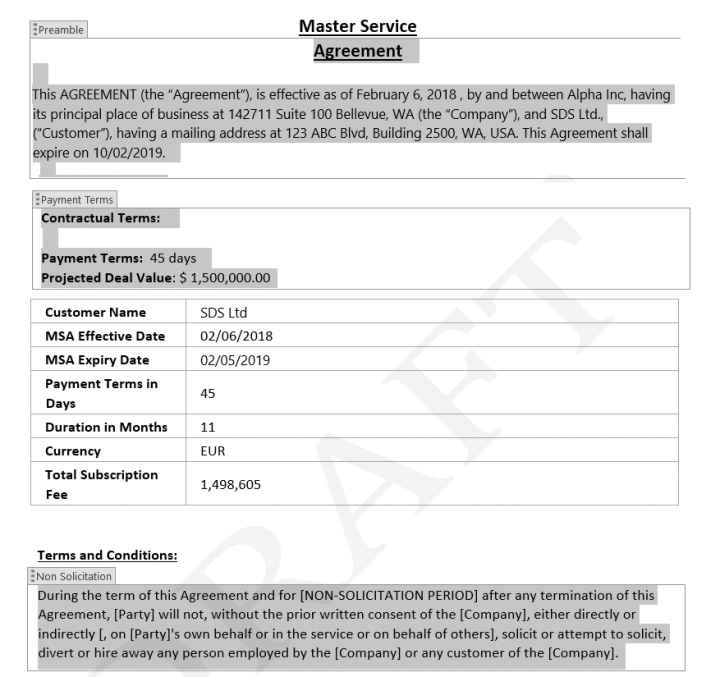| Line 5: | Line 5: | ||
= DiscoverAI = | = DiscoverAI = | ||
| + | |||
== Contract Highlights == | == Contract Highlights == | ||
| Line 20: | Line 21: | ||
#'''Create''' an ''Agreement Contract Type'' using ''Third Party Paper''. You can use an existing ''Agreement Contract Type'' as well. | #'''Create''' an ''Agreement Contract Type'' using ''Third Party Paper''. You can use an existing ''Agreement Contract Type'' as well. | ||
| − | + | <div class="image-green-border">[[File:Discover AI Contract Highlights 01.png|620px]]</div> <ol start="2"> | |
| + | <li>'''Click''' ''Next'', the ''Attributes'' page opens.</li> | ||
| + | <li>To be able to generate contract highlights from an Agreement, '''include''' the following attributes in the ''Agreement Contract Type'':</li> | ||
| + | </ol> | ||
| + | <ul style="margin-left: 40px;"> | ||
| + | <li>'''Contract Highlight Terms''': The ''Data Type'' must be selected as ''String''. In the ''Default Value'' attribute, '''enter''' the different terms or keywords expected in the highlight, separated by a pipe symbol. For example, Legal|Confidentiality|Liability|NoOfRecords:10.</li> | ||
| + | <li>'''Contract Highlights''': Here the ''Data Type RichTextArea'' must be selected.</li> | ||
| + | </ul> | ||
| + | <div class="image-green-border">[[File:Discover AI Contract Highlights 02.png|620px]]</div> <ol start="4"> | ||
| + | <li>'''Create''' an ''Associated Document Contract Type'', for example, ''ICMLegalHighlights'' to generate contract highlights for your legal department.</li> | ||
| + | </ol> | ||
| + | <div class="note-box">'''Note''': ''Allow Document Assembly'' must be set to ''Yes''.</div> | ||
| | ||
| − | + | <div class="image-green-border">[[File:Discover AI Contract Highlights 03.png|420px]]</div> <ol start="5"> | |
| − | + | <li>To add contract highlights in an ''Associated Document'', '''include''' the following attributes in the ''Associated Document Contract Type''.</li> | |
| − | + | </ol> | |
| − | + | ||
| − | + | ||
| − | + | ||
| − | + | ||
| − | + | ||
| − | + | ||
| − | + | ||
| − | + | ||
| − | + | ||
| − | + | ||
| − | + | ||
| − | + | ||
| − | + | ||
| − | + | ||
| − | + | ||
*'''Contract Highlight Terms''': The ''Data Type'' must be selected as ''String''. In the ''Default Value'' attribute, '''enter''' the different terms or keywords expected in the highlight, separated by a pipe symbol. For example, Legal|Confidentiality|Liability|NoOfRecords:10. | *'''Contract Highlight Terms''': The ''Data Type'' must be selected as ''String''. In the ''Default Value'' attribute, '''enter''' the different terms or keywords expected in the highlight, separated by a pipe symbol. For example, Legal|Confidentiality|Liability|NoOfRecords:10. | ||
| Line 45: | Line 42: | ||
To add the created ''Associated Document Contract Type'' to the ''Agreement Contract Type'': | To add the created ''Associated Document Contract Type'' to the ''Agreement Contract Type'': | ||
| − | + | <ol start="6"> | |
| − | + | <li>On the ''Contract Types'' page, '''click''' the ''Agreement Contract Type'' created earlier. The ''Details'' page for that contract type opens.</li> | |
| − | + | <li>'''Click''' the ''Edit'' button. The ''Edit Contract Type'' wizard opens.</li> | |
| − | + | <li>'''Navigate''' to the ''Association'' tab by clicking ''Next''.</li> | |
| − | + | <li>'''Click '''the plus icon next to ''Association''.</li> | |
| − | + | <li>'''Create '''an ''Association'' for the ''Associated Document Contract Type''.</li> | |
| − | + | </ol> | |
| − | + | <div class="image-green-border">[[File:Discover AI Contract Highlights 04.png|620px]]</div> | |
| − | + | ||
*'''Select''' the created ''Associated Document Contract Type''. You can set the ''Allow Multiple Instance'' option to ''Yes'', to allow different contract highlight associated documents to be created for different departments, such as legal or finance. | *'''Select''' the created ''Associated Document Contract Type''. You can set the ''Allow Multiple Instance'' option to ''Yes'', to allow different contract highlight associated documents to be created for different departments, such as legal or finance. | ||
| − | + | <ol start="11"> | |
| − | + | <li>'''Create''' a template for the ''Associated Document''.</li> | |
| − | + | </ol> | |
| + | <div class="image-green-border">[[File:Discover AI Contract Highlights 05.png|520px]]</div> <div class="image-green-border"> </div> <div class="note-box">'''Note''': Both the contract highlights attributes (''Contract Highlight Terms'' and ''Contract Highlights'') must be tagged within the template.</div> <ol start="12"> | ||
| + | <li>'''Create''' a ''Template Selection Rule'' for the ''Associated Document''.</li> | ||
| + | </ol> | ||
| + | <div class="image-green-border">[[File:Discover AI Contract Highlights 06.png|520px]]</div> <ol start="13"> | ||
| + | <li>'''Create''' an ''Event Rule'' with the action ''AITriggerContractHighlights''.</li> | ||
| + | </ol> | ||
| + | <div class="note-box">'''Note''': The ''Event'' selected must be any other than ''Agreement Created'', for example ''Agreement Published''.</div> <div class="image-green-border">[[File:Discover AI Contract Highlights 06.png|520px]]</div> <ol start="14"> | ||
| + | <li>To get the contract highlights in the ''Associated Document'', you need to '''create''' an ''Association'' with the ''Parent Agreement''.</li> | ||
| + | </ol> | ||
| + | <div class="image-green-border">[[File:Discover AI Contract Highlights 07.png|420px]]</div> <ol start="15"> | ||
| + | <li>'''Click''' ''Next''. The ''Meta Data'' page opens.</li> | ||
| + | <li>'''Enter''' the keywords in the ''Contract Highlight Terms''. For example, CEO|Liabilities | Amount |Penalty |obligation| regulation| price| jurisdiction|NoOfRecords:10.</li> | ||
| + | <li>'''Add''' ''NoOfRecords:n'' where 'n' denotes the number of contract highlights to be extracted. The default is ''NoOfRecords:20'', if the value of n is not specified in the keywords.</li> | ||
| + | <li>When an Agreement created using the selected ''Agreement Contract Type'' is published, the configured contract highlights will be extracted and compiled in the ''Associated Document''.</li> | ||
| + | </ol> | ||
| + | <div class="note-box">'''Note''': There are no changes to the existing Agreement workflow while configuring and generating the contract highlights.</div> | ||
| | ||
| − | |||
| − | |||
| − | |||
| − | |||
| − | |||
| − | |||
| − | |||
| − | |||
| − | |||
| − | |||
| − | |||
| − | |||
| − | |||
| − | |||
| − | |||
| − | |||
| − | |||
| − | |||
| − | |||
| − | |||
| − | |||
| − | |||
| − | |||
== Bulk Upload with Clause Discovery == | == Bulk Upload with Clause Discovery == | ||
Revision as of 03:55, 24 March 2020
Contents
DiscoverAI
Contract Highlights
Whenever contracts are sent to CXOs, legal or finance teams for their approval or signatures, they are interested to know if a certain language is present or absent in the contract. This helps them to understand the nuances of the contracts, viewpoints of various stakeholders, etc. and they can quickly take an informed decision.
With this release,
- The DiscoverAI model can find the terms in documents and highlight them for business decision makers. Configurators can now specify the important words by the business so that the DiscoverAI model can find matching as well as similar terms in documents and highlight them for the intended audience.
- In case no phrases are specified, then ICM will identify the important sections in the contract based on learnings from historical data. The identified sections will also be ranked in order of importance.
- A configurator can also specify the maximum number of highlights to be extracted from the agreements. The AI algorithm would rank the findings and present only the top ranked highlights to the user.
- Configurators can configure the event to generate the contract highlight, for example agreement updated, etc. Using this configuration, when the specified event occurs, ICM will identify the important sections of the contract based on historical data and phrases specified by the configurator
To configure generating contract highlights from an agreement:
- Create an Agreement Contract Type using Third Party Paper. You can use an existing Agreement Contract Type as well.
- Click Next, the Attributes page opens.
- To be able to generate contract highlights from an Agreement, include the following attributes in the Agreement Contract Type:
- Contract Highlight Terms: The Data Type must be selected as String. In the Default Value attribute, enter the different terms or keywords expected in the highlight, separated by a pipe symbol. For example, Legal|Confidentiality|Liability|NoOfRecords:10.
- Contract Highlights: Here the Data Type RichTextArea must be selected.
- Create an Associated Document Contract Type, for example, ICMLegalHighlights to generate contract highlights for your legal department.
- To add contract highlights in an Associated Document, include the following attributes in the Associated Document Contract Type.
- Contract Highlight Terms: The Data Type must be selected as String. In the Default Value attribute, enter the different terms or keywords expected in the highlight, separated by a pipe symbol. For example, Legal|Confidentiality|Liability|NoOfRecords:10.
- Contract Highlights: Here the Data Type RichTextArea must be selected.
To add the created Associated Document Contract Type to the Agreement Contract Type:
- On the Contract Types page, click the Agreement Contract Type created earlier. The Details page for that contract type opens.
- Click the Edit button. The Edit Contract Type wizard opens.
- Navigate to the Association tab by clicking Next.
- Click the plus icon next to Association.
- Create an Association for the Associated Document Contract Type.
- Select the created Associated Document Contract Type. You can set the Allow Multiple Instance option to Yes, to allow different contract highlight associated documents to be created for different departments, such as legal or finance.
- Create a template for the Associated Document.
- Create a Template Selection Rule for the Associated Document.
- Create an Event Rule with the action AITriggerContractHighlights.
- To get the contract highlights in the Associated Document, you need to create an Association with the Parent Agreement.
- Click Next. The Meta Data page opens.
- Enter the keywords in the Contract Highlight Terms. For example, CEO|Liabilities | Amount |Penalty |obligation| regulation| price| jurisdiction|NoOfRecords:10.
- Add NoOfRecords:n where 'n' denotes the number of contract highlights to be extracted. The default is NoOfRecords:20, if the value of n is not specified in the keywords.
- When an Agreement created using the selected Agreement Contract Type is published, the configured contract highlights will be extracted and compiled in the Associated Document.
Bulk Upload with Clause Discovery
To upload Agreements in bulk:
1. Click the Agreements tile. The Agreement Management page opens. Let us take an example of an Agreement Contract Type (CT1) that should have already been created and published.
2. Click the Bulk Upload tile. The Bulk Upload page opens.
3. Enter the Request Name.
4. Click the Select Batch File button to select the file for a bulk upload. In this example, we are selecting the LegacyBulkUpload.zip file.
- The Meta.xlsx files contains data related to ContractType (CT1 in this case), CTTypeofContract (Agreement Contract Type), Technical Name of the Attributes present in the Contract and Display Name of the Attributes.
- The Data.xlsx files contains all the Attributes in Contract Type (CT1) as a column name in which the data gets auto-populated from the PDF/docx file. User needs to add the Bulk Upload Business Status is Executed and the file name under File Path column in Data.xlsx file. 5. Click the Submit button. The File Uploaded Successfullymessage is displayed.
5. Click the Submit button. The File Uploaded Successfully message is displayed.
6. Click OK. The file is now displayed in the Grid view with the status Not Started.
7. Click Refresh icon twice. On first Refresh, the Status changes to In Progress and then to Needs Validation.
8. Select an Actions radio button for the file that you want to finalize. The Validate and Finalize buttons are enabled.
9. Click the Validate button to download the PopulatedData.xlsx file. The values of the Attributes can be edited in this file.
Note: The data in the Excel sheet that is marked green signifies the highest confidence level, data in yellow indicates medium confidence level and data in red indicates lowest confidence level. You can then make any changes to the Attribute values. (In this example, you can make changes to the Attribute value from the downloaded PopulatedData.xlsx file).
10. Click Save to save the changes.
11. Click the Finalize button, the PopulatedData.xlsx file can be uploaded. The Finalized File Uploaded Successfully message is displayed.
12. The Needs Validation status changes to Completed.
13. Click the Agreements tile to view the Agreements which will be in the Draft state.
Table Discovery
Along with clauses and metadata, ICM also extracts tables (including information such as SLAs, price list, etc.) in Agreements and displays them on the Tables tab (on the Details page). ICM tries to match the discovered table(s) with the Associated Contract Types of the Agreement. If a strong match is found, then the table is tagged with that Associated Contract Type, and the table columns are also matched with the Attributes of that Associated Contract Type.
You can then take relevant action such as creating new instances of the Associations. Automatically recognizing table data inside the Agreements saves a lot of manual labor of identifying and tagging the data correctly.
The table discovery allows you to:
- Identify and discover the table(s) in the Agreement Document
- Update the data in the discovered table as required
- Create new instances of the Associations for the uploaded Agreement
The table discovery in PDF agreements works well with:
- Tables with well-defined borders in text PDFs and high-quality scanned PDFs
- Tables that may be slightly skewed or tilted
- Table cells with light-colored backgrounds
The table discovery in PDF agreements may not work well with:
- Tables in low-quality scanned PDFs and those without borders
- Tables without well-defined borders or characters overlapping the table border, etc., due to certain OCR limitations
- Certain non-table elements, such as flowcharts and diagrams
- Tables with merged columns and rows
- Nested tables, which may be discovered as multiple tables
Discovering Tables in an Agreement
To discover tables in an Agreement:
1. Create an Agreement (Third Party Type Of Paper).
2. Ensure that the Clause Discovery functionality is turned On and the Contract Type is enabled for table discovery.
3. Create and Publish the Agreement. ICM automatically queues the Agreement for table discovery.
Viewing Discovered Tables in an Agreement
You can view all the discovered tables in an Agreement, so that you can review them and take actions as needed (based on whether they meet the criteria for creating an associated document or not).
1. Click the Tables tab on the uploaded Agreement Details page.
2. ICM displays a list of the Discovered Tables for that Agreement Document.
Editing Table Data
1. Click the Edit Table Name icon next the table that you want to edit. For example, Table 2.
2. Toggle the Has Header button toYes if you want the table to have a header.
3. Click inside the header box to add the header name. For example, PSE Workers, Term, etc.
4. Click inside each of the boxes to add data in the columns. For example, 3.0 (Version), 09 Sep, 2019 (Date Released), etc.
5. Click Save Changes to save changes if you want to review or edit them later. The Table data saved message is displayed.
6. Select the Association for which you want to create this data from the Select Association drop-down. For example, Payment Details.
7. A validation message is displayed to check if you want to save the updated data. Click Save to update the data in the table, else click Discard.
8. Select the checkbox for the rows and columns that you want to update.
9. Click Finish. A validation message is displayed informing you that you will not be able to make any changes to the table data after this.
10. Click Yes if you are sure that you want to update the table and proceed.
11. A message is displayed indicating that the table data is saved and the Associations are being created. Click Yes if you are sure that you want to update the table and proceed, else click No.
12. You can view the associations on the Associations tab.
13. Click View Record to view the details of the individual records.
14. You can take further action as needed. For example, send it for Approval.
Selecting the Type of Table to be able to create Associations for it
You can create Associated Documents using the data in the discovered tables. You are basically discovering the Associated Document type and the columns associated with that document type.
To do so:
1. Click the Tables tab on the uploaded Agreement Details page.
2. In the Discovered Tables window when matching data is present, the exact Associations with that table are discovered. For example, the Payment Details are discovered. These are associated and the names of the header are also discovered.
3. You can select whether the table should have a header or not by enabling the Has Header flag to Yes.
By doing this, the first row of the table will be marked as the header and Associations will not be created for it. If there are 2 rows other than the header, then 2 Associations will be created. A green tick mark will be displayed next to them which means that they are successfully created in the Tables tab.
4. In the Discovered Tables window, make changes in the table as required. For example, select 3 rows and columns.
Saving the changes of the Table Discovery for the Agreement
You can save the interim progress of the Table Discovery for an Agreement, so that you can review it later by:
1. Click Save Changes. The Table data saved message is displayed.
Finishing the Table Identification for an Agreement
You can complete the Table identification for an Agreement, so that the identified tables become part of the Agreement.
1. Click Finish. A message will be displayed indicating that you will not be able to make any changes to the table data.
2. Click Yes if you are certain that you want to make the changes, else you can save changes and review them later.
3. Click the Associations tab to see the Associations that are discovered, as shown in the screenshot below:
4. Click the Payment Details association to view the details and send for approval.
5. Click Export to Excel if you want to export the table that has been discovered.
Note:
- Once the Associations are created, you cannot make any changes to the table. The table is disabled and the status changes to Review Completed.
- It is not necessary to match every table to one of the association contract type. You can still make changes to such tables and download them using ‘Export to excel’ functionality.
DiscoverAI - Support for Own Paper
ICM already leverages the DiscoverAI app to discover attributes, clauses, tables and obligations in agreements created using third party paper type.
Now, ICM has extended the support to discover attributes, clauses, tables and obligations in agreements created using own paper type, and tagging the attributes and clauses to the original agreement document. This helps convert unstructured documents into structured agreements, making it easier to manage and also increase compliance.
Note:
- Tagging is supported only in Word documents.
- The attributes and clauses that have been confirmed in ICM (even on the web UI) are tagged back in the agreement document.
Discovering Attributes, Clauses, Tables and Obligations
To discover attributes, clauses, tables and obligations using own type of paper:
1. Create an agreement using Own Type of Paper.
2. Click Next. The Attributes page opens.
3. Select Discover AI from the Clause Discovery Type drop-down and ML based from the Obligation Discovery Type drop-down.
4. Click Next. The Select Template page opens.
5. Select a template or upload a file.
6. Click Next.
7. Click Create and Publish. The agreement Details page opens.
All non-tagged attributes, clauses, tables (if present in the agreement document) and obligations (if you select the value in the Obligation Discovery Type drop-down) are discovered.
Tagging Discovered Attributes
1. Click the Attributes tab.
2. Click Save to confirm the attributes. You can also modify the discovered attribute values by clicking the View potential matching values icon and then click Save.
3. The Metadata Save Confirmation message is displayed.
4. Click the Versions tab.
5. Download the latest version of the agreement in Word format. The discovered attributes are tagged as ICM attributes in the agreement document, as shown in the screenshot below:
Tagging Discovered Clauses
1. Click the Clauses tab. The discovered clauses are displayed.
2. Take actions (such as Confirm, Confirm with Deviation, Ignore, Review Later) on the discovered clauses.
3. Click Finish to complete the review process, as shown in the screenshot below:
4. Click the Versions tab. A new version of the agreement is created in both Word and PDF formats.
5. Download the latest version. The confirmed clauses are tagged as ICM clauses in the agreement document.
Note:
- If you create a new agreement and upload the Word document that was downloaded in Step 5, the discovery will be triggered, however the clauses that were already confirmed and tagged as ICM clauses are not displayed.
- Only when the agreement is published, the clauses that you confirm on clicking Finish will be saved as ICM clauses and displayed in the Agreement Clauses tab on the Details page.
- A new agreement version is created each time you save the discovered attributes and confirm the clauses by clicking Finish.
Inbuilt Discovery of Attributes and Clauses
Previously, discovering attributes and clauses in customers’ agreement documents was time consuming as it required retraining of the algorithms from scratch, causing delay in deployment of services.
Now, ICM has an inbuilt discovery model that helps to automatically extract and discover the most common attributes and clauses in agreements besides enhancing clause delineation in third party contracts. This facilitates the prediction of accurate clause categories and capturing the right metadata within clauses. This improves contract turnaround time and quality of results, thus leading to improved user experience.
The inbuilt discovery model supports the discovery of the following predefined attributes and clauses in any MSA, NDA and SOW third party paper contract types:
- Attributes: Party Name, Party Address, Effective Date, Expiry Date, Contract Value, Contract Duration, Renewal, EverGreen, PaymentTerms, Jurisdiction, Governing Law andNotice Period For Termination
Note: The Contract Value attribute supports the following currencies - USD, CAD, EUR, INR and CAN
- Clauses: Amendment, Assignment, Audit, Confidential Information, Conflicts, Counterparts, Definitions, Dispute Resolution, Entire Agreement, Force Majeure, Governing Law, Indemnification, Insurance, Intellectual Property Rights, Limitation Of Liability, Non-Compete, Non-Solicitation, Notices, Payment Terms, Penalties/Remedies, Personnel, Preamble, Publicity, Relationship Of Parties, Representations, Warranties and Compliances, Severability, Signature, Survival, Taxes, Term, Termination and Waiver
Discovering Common Attributes and Clauses
1. Create an agreement using Third Party Type of Paper.
2. Click Next. The Attributes page opens.
3. Upload a file and click Next.
4. Click Create and Publish. The agreement Details page opens.
The most common attributes and clauses from the agreement document that you uploaded in Step 3 are discovered and displayed in the Attributes and Clauses tab, as shown in the screenshots below for Attributes and Clauses respectively:
Attributes:
- Click the View potential matching values icon next to the discovered attribute values to take actions on them such as Accept, Reject or Keep Selected Text.
- The attribute values are normalized and displayed based on the defined rules. For example, the Effective Date is displayed in the ICM-supported format, as shown in the screenshot below:
Clauses:
- You can filter clauses based on Action Status, Clause categories and Confidence.
- The level of confidence associated with Discovered Clauses is displayed using different color indicators to depict High (green), Medium (orange) and Low (pink) confidence. All discovered clauses have the Review link next to them until you click it to take an action (such as Confirm, Confirm with Deviation, Ignore or Review Later). In addition, clauses with obligations have the
icon next to them. You can click the icon to view the obligations.
- Click the Finish button to complete the review process.
Related Topics: Agreement Management | Obligation Management | Managing US Federal Contracts using ICM | Contract Digitalization | NegotiateAI | ObligationAI | VisualizeAI







